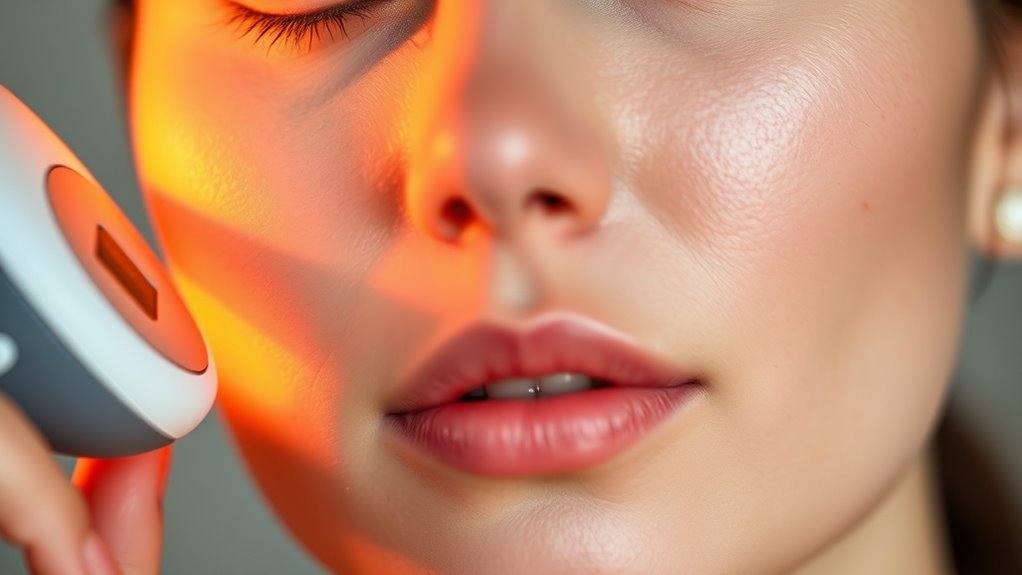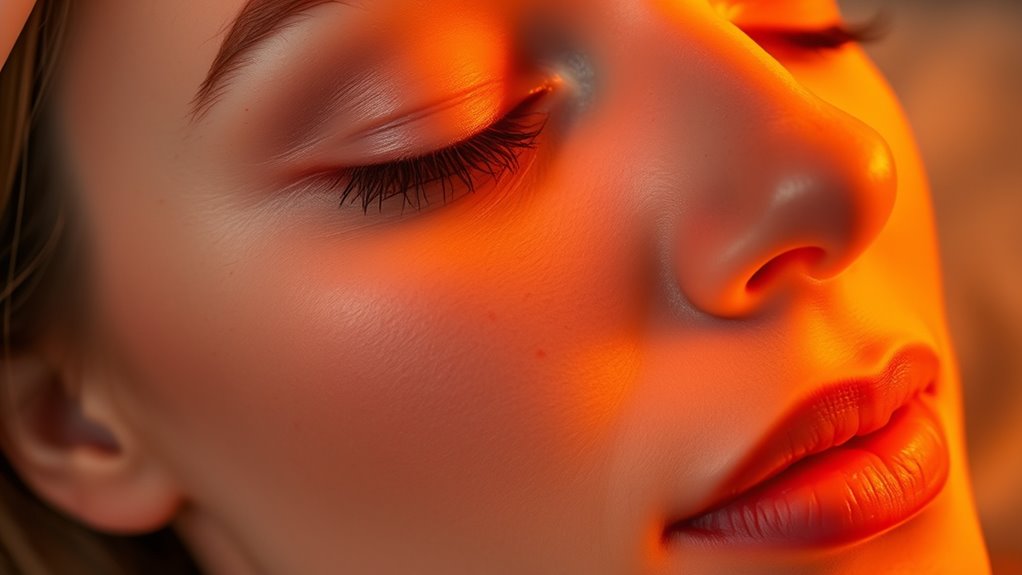When using light therapy on sensitive skin, start with low intensity and short sessions to prevent irritation. Gradually increase the time and frequency as your skin adapts, monitoring its response after each treatment. Choose devices designed for sensitive skin and perform patch tests beforehand. Be patient, follow safety guidelines, and avoid rushing into longer or more frequent sessions. Continue exploring effective strategies to guarantee your skin benefits safely over time.
Key Takeaways
- Begin with brief, low-wavelength sessions to minimize irritation and monitor skin response carefully.
- Gradually increase treatment duration and frequency based on your skin’s tolerance and comfort.
- Choose devices specifically designed for sensitive skin and perform patch tests before full use.
- Follow a gentle skincare routine, avoiding harsh products and protecting skin from environmental stressors.
- Consult a dermatologist for personalized guidance on safe settings and effective treatment plans.

If you have sensitive skin, finding gentle yet effective skincare treatments can be challenging. Light therapy has gained popularity as a non-invasive option that can improve skin health without harsh chemicals or aggressive procedures. However, with sensitive skin, it’s essential to approach light therapy carefully. The key is to start low and go slow, giving your skin time to adjust and minimizing the risk of irritation or adverse reactions.
For sensitive skin, start light therapy slowly to protect your skin and prevent irritation.
When considering light therapy, select devices designed specifically for sensitive skin. These often use lower wavelengths or reduced energy levels to deliver benefits safely. Before your first treatment, perform a patch test on a small area of skin, such as behind the ear or on the inner forearm. Wait at least 24 hours to check for any signs of redness, itching, or irritation. If no adverse effects occur, you can proceed, but still with caution.
Begin with shorter sessions, perhaps just a few minutes, and observe how your skin responds. It’s better to start with less frequent treatments, maybe once or twice a week, rather than daily. This approach allows your skin to build tolerance gradually. Over time, if your skin handles the initial sessions well, you can consider slightly increasing the duration or frequency, but always paying close attention to how your skin reacts after each treatment.
Consistency is essential, but so is patience. Sensitive skin often needs more time to show improvement, and rushing into more frequent or longer sessions can cause setbacks. Keep a skincare journal to track your treatments and any changes in your skin’s condition. This record can help you and your dermatologist fine-tune your regimen for optimal results.
It’s also important to integrate gentle skincare routines alongside light therapy. Use soothing, fragrance-free cleansers and moisturizers to support your skin’s barrier function. Avoid harsh exfoliants or irritating ingredients during this period. Protect your skin from environmental stressors like wind, sun, and extreme temperatures, which can exacerbate sensitivity.
Additionally, understanding the importance of HEPA filtration in air purifiers can help ensure a healthier environment, supporting your skin’s recovery and overall wellness. Lastly, consult with a dermatologist or skincare professional before starting light therapy. They can recommend the right device, settings, and treatment plan tailored to your sensitive skin. Remember, the goal is to enhance your skin’s health without causing harm. By starting low, going slow, and listening to your skin’s responses, you can safely enjoy the benefits of light therapy while minimizing risks.
Frequently Asked Questions
Can Light Therapy Cause Long-Term Skin Damage for Sensitive Skin?
Light therapy is generally safe for sensitive skin if you follow proper guidelines, but long-term damage is unlikely when used correctly. You should always start with low settings and gradually increase exposure to minimize risks. If you notice irritation or adverse effects, stop treatment and consult a dermatologist. Properly administered, light therapy can improve skin without causing lasting damage, but vigilance and professional guidance are key.
What Are the Signs of a Negative Reaction During Treatment?
Imagine you’re in a sci-fi flick, but real life’s less dramatic. During treatment, signs of a negative reaction include redness, swelling, or a burning sensation. You might also notice increased sensitivity or itching. If any of these occur, stop immediately and consult your dermatologist. Don’t ignore these signals—acting quickly helps prevent further irritation, ensuring your skin stays safe while you enjoy the benefits of light therapy.
How Often Should I Adjust My Light Therapy Routine?
You should adjust your light therapy routine based on your skin’s response, typically every 2-4 weeks. If you notice increased redness, irritation, or discomfort, reduce the session duration or frequency. Conversely, if your skin tolerates the treatment well, you can gradually increase exposure. Always listen to your skin and consult a dermatologist if unsure, ensuring you avoid overexposure and negative reactions.
Are There Specific Light Wavelengths Better for Sensitive Skin?
You’ll want to focus on wavelengths around 630-700nm (red light) and 415nm (blue light), which are generally gentler for sensitive skin. Studies show red light boosts collagen without irritation, making it ideal for delicate skin. Blue light can help with acne but might cause dryness or redness if overused. Always start with lower intensities and shorter durations to see how your skin responds, then adjust accordingly.
Can Light Therapy Be Combined With Other Skincare Treatments Safely?
Yes, you can combine light therapy with other skincare treatments safely, but you should consult your dermatologist first. They can recommend compatible treatments and make certain no adverse reactions occur. Typically, light therapy works well with gentle skincare routines, like moisturizing and sun protection. Avoid combining it with harsh chemicals or aggressive treatments unless your dermatologist approves, so you keep your sensitive skin safe and effective.
Conclusion
Remember, when it comes to light therapy for sensitive skin, patience is your gentle guide. Start with the softest touch, and listen to your skin’s quiet whispers. Proceed gradually, allowing your skin to find its comfort zone. With time and care, you’ll discover a soothing rhythm that nurtures your glow. Trust the process, and soon, you’ll find your skin basking in the gentle, healing light it’s been waiting for.








